fuel cap MERCEDES-BENZ G-Class 2012 W463 Owner's Manual
[x] Cancel search | Manufacturer: MERCEDES-BENZ, Model Year: 2012, Model line: G-Class, Model: MERCEDES-BENZ G-Class 2012 W463Pages: 284, PDF Size: 9.4 MB
Page 10 of 284
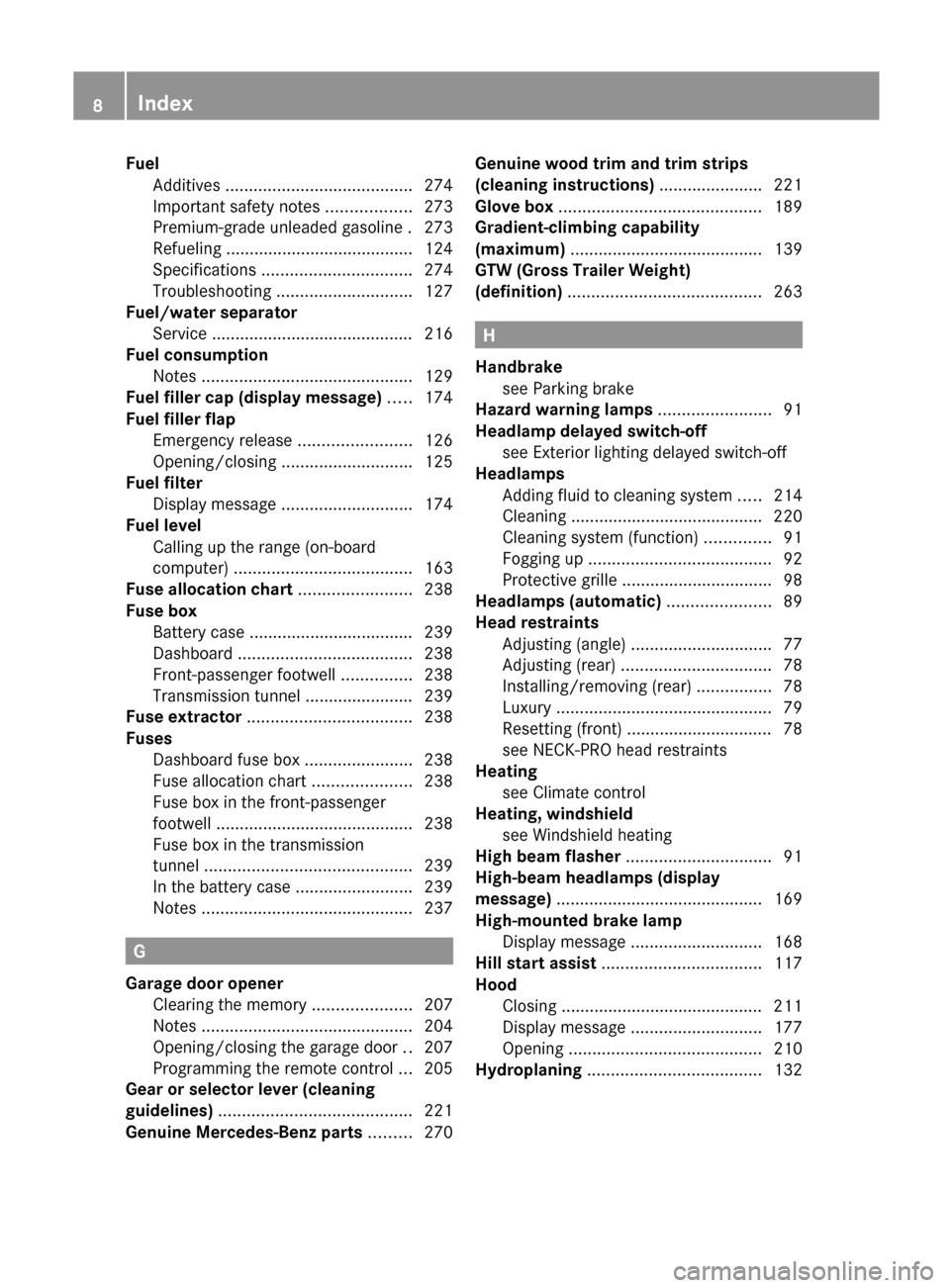
Fuel
Additives ........................................ 274
Important safety notes
..................273
Premium-grade unleaded gasoline . 273
Refueling ........................................ 124
Specifications ................................ 274
Troubleshooting ............................. 127
Fuel/water separator
Service ........................................... 216
Fuel consumption
Notes ............................................. 129
Fuel filler cap (display message) .....174
Fuel filler flap Emergency release ........................ 126
Opening/closing ............................ 125
Fuel filter
Display message ............................ 174
Fuel level
Calling up the range (on-board
computer) ...................................... 163
Fuse allocation chart ........................238
Fuse box Battery case ................................... 239
Dashboard ..................................... 238
Front-passenger footwell ...............238
Transmission tunnel ....................... 239
Fuse extractor ................................... 238
Fuses Dashboard fuse box ....................... 238
Fuse allocation chart ..................... 238
Fuse box in the front-passenger
footwell .......................................... 238
Fuse box in the transmission
tunnel ............................................ 239
In the battery case ......................... 239
Notes ............................................. 237G
Garage door opener Clearing the memory
.....................207
Notes ............................................. 204
Opening/closing the garage door ..207
Programming the remote control ... 205
Gear or selector lever (cleaning
guidelines) ......................................... 221
Genuine Mercedes-Benz parts ......... 270Genuine wood trim and trim strips
(cleaning instructions)
......................221
Glove box ........................................... 189
Gradient-climbing capability
(maximum) ......................................... 139
GTW (Gross Trailer Weight)
(definition) ......................................... 263 H
Handbrake see Parking brake
Hazard warning lamps ........................91
Headlamp delayed switch-off see Exterior lighting delayed switch-off
Headlamps
Adding fluid to cleaning system .....214
Cleaning ......................................... 220
Cleaning system (function) .............. 91
Fogging up ....................................... 92
Protective grille ................................ 98
Headlamps (automatic) ......................89
Head restraints Adjusting (angle) .............................. 77
Adjusting (rear) ................................ 78
Installing/removing (rear) ................ 78
Luxury .............................................. 79
Resetting (front) ............................... 78
see NECK-PRO head restraints
Heating
see Climate control
Heating, windshield
see Windshield heating
High beam flasher ............................... 91
High-beam headlamps (display
message) ............................................ 169
High-mounted brake lamp Display message ............................ 168
Hill start assist .................................. 117
Hood Closing ........................................... 211
Display message ............................ 177
Opening ......................................... 210
Hydroplaning ..................................... 1328
Index
Page 14 of 284
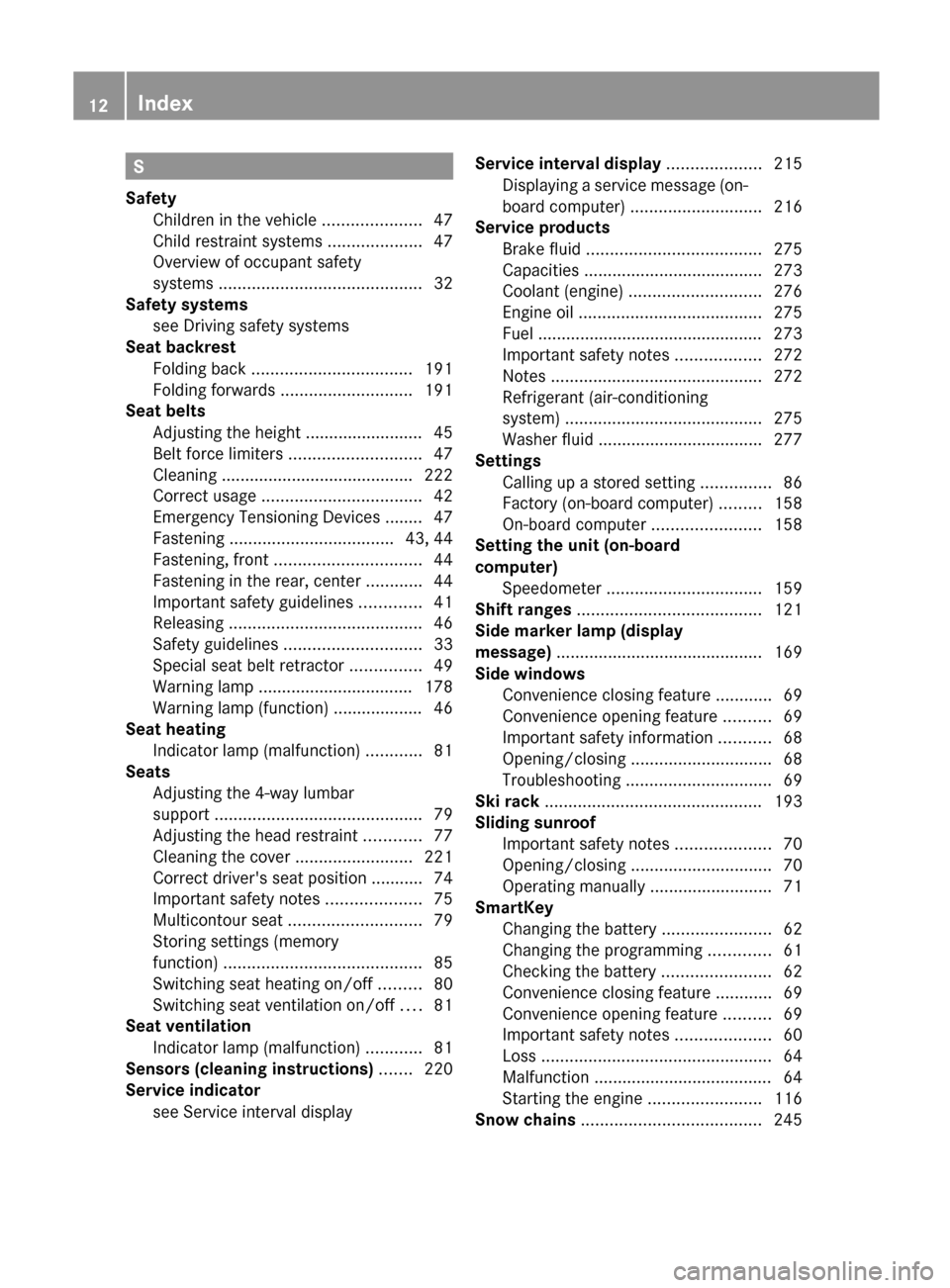
S
Safety Children in the vehicle .....................47
Child restraint systems ....................47
Overview of occupant safety
systems ...........................................
32
Safety systems
see Driving safety systems
Seat backrest
Folding back .................................. 191
Folding forwards ............................ 191
Seat belts
Adjusting the height ......................... 45
Belt force limiters ............................ 47
Cleaning ......................................... 222
Correct usage .................................. 42
Emergency Tensioning Devices ........ 47
Fastening ................................... 43, 44
Fastening, front ............................... 44
Fastening in the rear, center ............44
Important safety guidelines .............41
Releasing ......................................... 46
Safety guidelines ............................. 33
Special seat belt retractor ............... 49
Warning lamp ................................. 178
Warning lamp (function) ................... 46
Seat heating
Indicator lamp (malfunction) ............ 81
Seats
Adjusting the 4-way lumbar
support ............................................ 79
Adjusting the head restraint ............ 77
Cleaning the cover ......................... 221
Correct driver's seat position ........... 74
Important safety notes .................... 75
Multicontour seat ............................ 79
Storing settings (memory
function) .......................................... 85
Switching seat heating on/off ......... 80
Switching seat ventilation on/off ....81
Seat ventilation
Indicator lamp (malfunction) ............ 81
Sensors (cleaning instructions) .......220
Service indicator see Service interval display Service interval display
....................215
Displaying a
service message (on-
board computer) ............................ 216
Service products
Brake fluid ..................................... 275
Capacities ...................................... 273
Coolant (engine) ............................ 276
Engine oil ....................................... 275
Fuel ................................................ 273
Important safety notes .................. 272
Notes ............................................. 272
Refrigerant (air-conditioning
system) .......................................... 275
Washer fluid ................................... 277
Settings
Calling up a stored setting ............... 86
Factory (on-board computer) ......... 158
On-board computer ....................... 158
Setting the unit (on-board
computer)
Speedometer ................................. 159
Shift ranges ....................................... 121
Side marker lamp (display
message) ............................................ 169
Side windows Convenience closing feature ............ 69
Convenience opening feature .......... 69
Important safety information ........... 68
Opening/closing .............................. 68
Troubleshooting ............................... 69
Ski rack .............................................. 193
Sliding sunroof Important safety notes .................... 70
Opening/closing .............................. 70
Operating manually ..........................71
SmartKey
Changing the battery ....................... 62
Changing the programming ............. 61
Checking the battery ....................... 62
Convenience closing feature ............ 69
Convenience opening feature .......... 69
Important safety notes .................... 60
Loss ................................................. 64
Malfunction ...................................... 64
Starting the engine ........................ 116
Snow chains ...................................... 24512
Index
Page 27 of 284

Instrument cluster
Overview
Function Page
:
Speedometer
;
Multifunction display 154
=
Tachometer 152
?
Fuel filler flap location
indicator: the fuel filler cap
is to the rear on the right
124 Function Page
A
Fuel gauge
B
Coolant temperature gauge 152
C
Reset button 156Instrument cluster
25
At a glance
Page 127 of 284
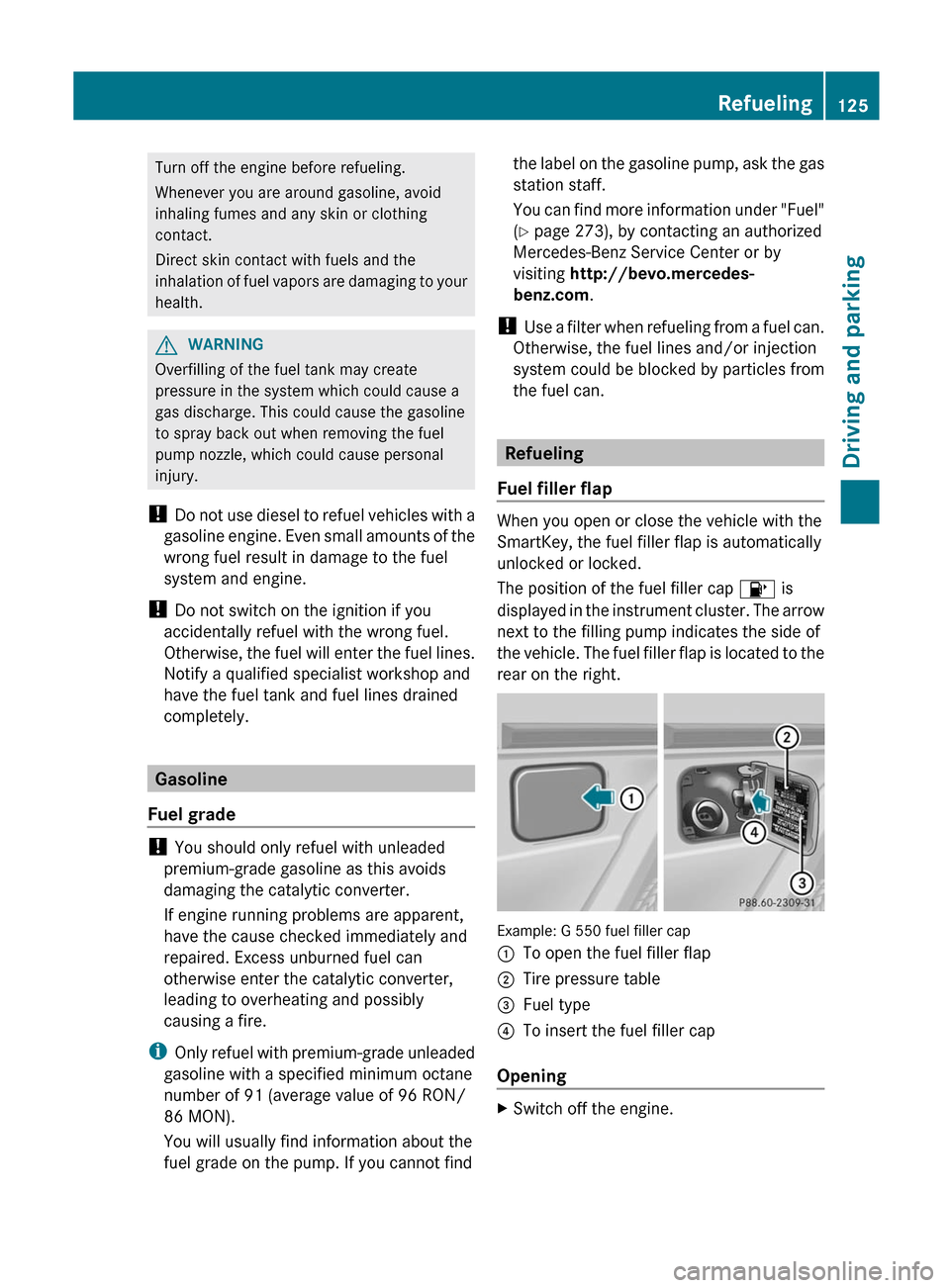
Turn off the engine before refueling.
Whenever you are around gasoline, avoid
inhaling fumes and any skin or clothing
contact.
Direct skin contact with fuels and the
inhalation
of
fuel vapors are damaging to your
health. G
WARNING
Overfilling of the fuel tank may create
pressure in the system which could cause a
gas discharge. This could cause the gasoline
to spray back out when removing the fuel
pump nozzle, which could cause personal
injury.
! Do not
use diesel to refuel vehicles with a
gasoline engine. Even small amounts of the
wrong fuel result in damage to the fuel
system and engine.
! Do not switch on the ignition if you
accidentally refuel with the wrong fuel.
Otherwise, the fuel will enter the fuel lines.
Notify a qualified specialist workshop and
have the fuel tank and fuel lines drained
completely. Gasoline
Fuel grade !
You should only refuel with unleaded
premium-grade gasoline as this avoids
damaging the catalytic converter.
If engine running problems are apparent,
have the cause checked immediately and
repaired. Excess unburned fuel can
otherwise enter the catalytic converter,
leading to overheating and possibly
causing a fire.
i Only refuel
with premium-grade unleaded
gasoline with a specified minimum octane
number of 91 (average value of 96 RON/
86 MON).
You will usually find information about the
fuel grade on the pump. If you cannot find the label on the gasoline pump, ask the gas
station staff.
You
can
find more information under "Fuel"
(Y page 273), by contacting an authorized
Mercedes-Benz Service Center or by
visiting http://bevo.mercedes-
benz.com.
! Use a filter when refueling from a fuel can.
Otherwise, the fuel lines and/or injection
system could be blocked by particles from
the fuel can. Refueling
Fuel filler flap When you open or close the vehicle with the
SmartKey, the fuel filler flap is automatically
unlocked or locked.
The position of the fuel filler cap
8
is
displayed in
the instrument cluster. The arrow
next to the filling pump indicates the side of
the vehicle. The fuel filler flap is located to the
rear on the right. Example: G 550 fuel filler cap
:
To open the fuel filler flap
; Tire pressure table
= Fuel type
? To insert the fuel filler cap
Opening X
Switch off the engine. Refueling
125
Driving and parking Z
Page 128 of 284

i
When the engine is running and the fuel
filler flap is open, the yellow reserve fuel
warning lamp and the = (USA only)
or ; (Canada only) Check Engine
warning lamp may light up.
For further information on warning and
indicator lamps in the instrument cluster,
see ( Y page 184).
X Remove the SmartKey from the ignition
lock.
X Press the fuel filler flap in the direction of
arrow :.
The fuel filler flap opens slightly.
X Open the fuel filler flap.
X Turn the fuel filler cap counterclockwise
and remove it.
X Insert the fuel filler cap into the holder
bracket on the inside of filler flap ?.
X Completely insert the fuel pump nozzle into
the filler neck and refuel.
X Only fill the tank until the pump nozzle
switches off.
! Overfilling the
fuel tank could damage the
fuel system.
Closing X
Replace the fuel filler cap and turn it
clockwise. The fuel filler cap audibly
engages.
X Close the fuel filler flap.
i Close the
fuel filler flap before locking the
vehicle. A locking pin otherwise prevents
the fuel filler flap from closing after the
vehicle has been locked. Fuel filler flap emergency release
G
WARNING
Avoid contact with the vehicle walls as they
may contain sharp edges. Otherwise, you
could injure yourself while releasing the fuel
filler flap. The emergency release is located in the cargo
compartment, on the right-hand side when
viewed in the direction of travel, behind the
rear panel trim.
X
Open the rear door. X
Disconnect edge guard : on the door
pillar.
X Remove rear panel trim ;. X
Pull emergency release = in the direction
of the arrow.
The fuel filler flap is unlocked.
X Open the fuel filler flap.126
Refueling
Driving and parking
Page 138 of 284
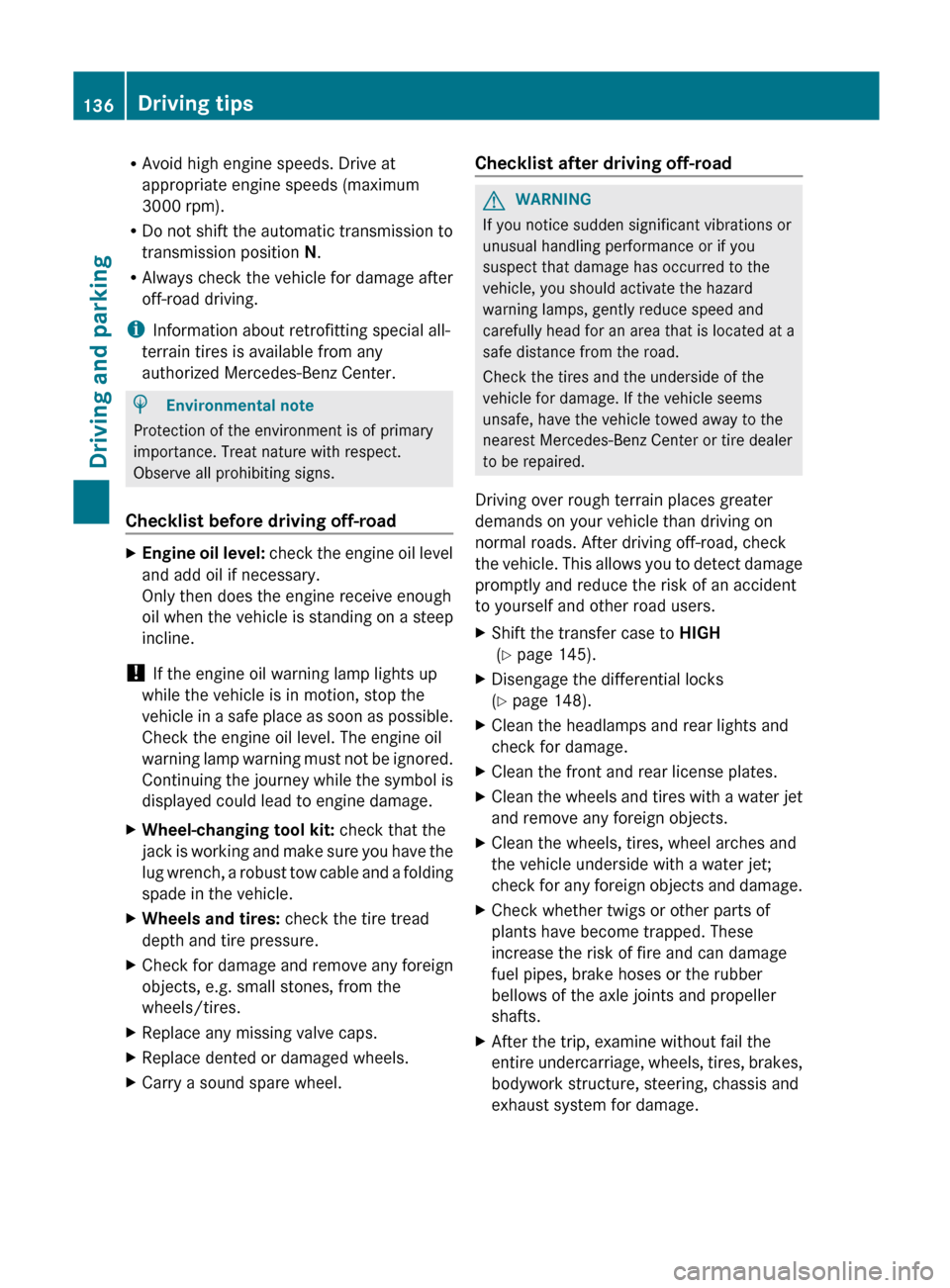
R
Avoid high engine speeds. Drive at
appropriate engine speeds (maximum
3000 rpm).
R Do not shift the automatic transmission to
transmission position N.
R Always check the vehicle for damage after
off-road driving.
i Information about retrofitting special all-
terrain tires is available from any
authorized Mercedes-Benz Center. H
Environmental note
Protection of the environment is of primary
importance. Treat nature with respect.
Observe all prohibiting signs.
Checklist before driving off-road X
Engine oil level: check the engine oil level
and add oil if necessary.
Only then does the engine receive enough
oil when the vehicle is standing on a steep
incline.
! If the engine oil warning lamp lights up
while the vehicle is in motion, stop the
vehicle in
a safe place as soon as possible.
Check the engine oil level. The engine oil
warning lamp warning must not be ignored.
Continuing the journey while the symbol is
displayed could lead to engine damage.
X Wheel-changing tool kit: check that the
jack is
working and make sure you have the
lug wrench, a robust tow cable and a folding
spade in the vehicle.
X Wheels and tires: check the tire tread
depth and tire pressure.
X Check for damage and remove any foreign
objects, e.g. small stones, from the
wheels/tires.
X Replace any missing valve caps.
X Replace dented or damaged wheels.
X Carry a sound spare wheel. Checklist after driving off-road G
WARNING
If you notice sudden significant vibrations or
unusual handling performance or if you
suspect that damage has occurred to the
vehicle, you should activate the hazard
warning lamps, gently reduce speed and
carefully head for an area that is located at a
safe distance from the road.
Check the tires and the underside of the
vehicle for damage. If the vehicle seems
unsafe, have the vehicle towed away to the
nearest Mercedes-Benz Center or tire dealer
to be repaired.
Driving over rough terrain places greater
demands on your vehicle than driving on
normal roads. After driving off-road, check
the vehicle.
This allows you to detect damage
promptly and reduce the risk of an accident
to yourself and other road users.
X Shift the transfer case to HIGH
(Y page 145).
X Disengage the differential locks
(Y page 148).
X Clean the headlamps and rear lights and
check for damage.
X Clean the front and rear license plates.
X Clean the wheels and tires with a water jet
and remove any foreign objects.
X Clean the wheels, tires, wheel arches and
the vehicle underside with a water jet;
check for
any foreign objects and damage.
X Check whether twigs or other parts of
plants have become trapped. These
increase the risk of fire and can damage
fuel pipes, brake hoses or the rubber
bellows of the axle joints and propeller
shafts.
X After the trip, examine without fail the
entire undercarriage,
wheels, tires, brakes,
bodywork structure, steering, chassis and
exhaust system for damage. 136
Driving tips
Driving and parking
Page 176 of 284
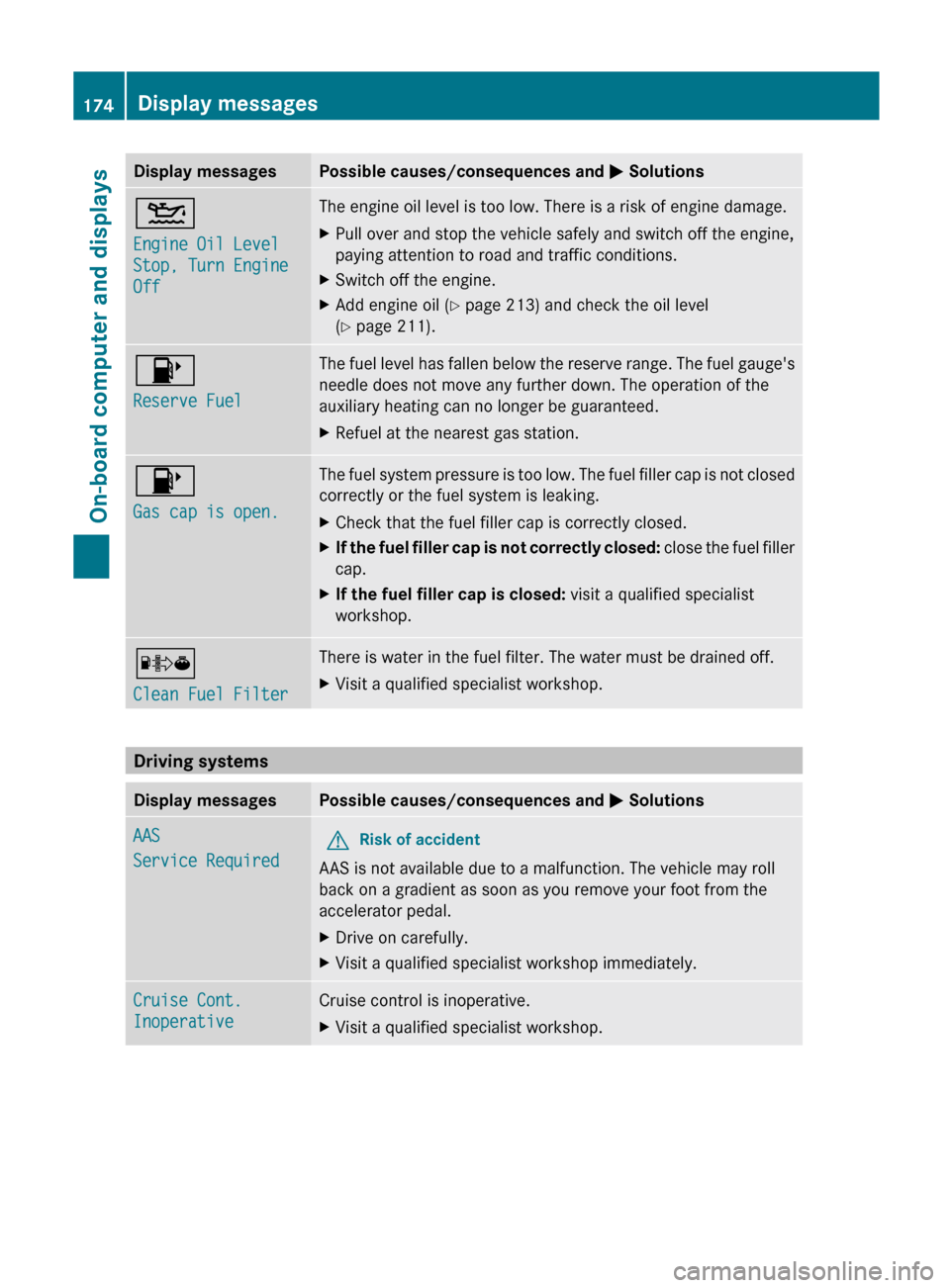
Display messages Possible causes/consequences and
M Solutions4
Engine Oil Level
Stop, Turn Engine
Off The engine oil level is too low. There is a risk of engine damage.
X
Pull over and stop the vehicle safely and switch off the engine,
paying attention to road and traffic conditions.
X Switch off the engine.
X Add engine oil ( Y page 213) and check the oil level
(Y page 211). 8
Reserve Fuel The fuel level has fallen below the reserve range. The fuel gauge's
needle does not move any further down. The operation of the
auxiliary heating can no longer be guaranteed.
X
Refuel at the nearest gas station. 8
Gas cap is open. The fuel system pressure is too low. The fuel filler cap is not closed
correctly or the fuel system is leaking.
X
Check that the fuel filler cap is correctly closed.
X If the fuel filler cap is not correctly closed:
close the fuel filler
cap.
X If the fuel filler cap is closed: visit a qualified specialist
workshop. ´
Clean Fuel Filter There is water in the fuel filter. The water must be drained off.
X
Visit a qualified specialist workshop. Driving systems
Display messages Possible causes/consequences and
M SolutionsAAS
Service Required
G
Risk of accident
AAS is not available due to a malfunction. The vehicle may roll
back on a gradient as soon as you remove your foot from the
accelerator pedal.
X Drive on carefully.
X Visit a qualified specialist workshop immediately. Cruise Cont.
Inoperative Cruise control is inoperative.
X
Visit a qualified specialist workshop.174
Display messages
On-board computer and displays
Page 186 of 284
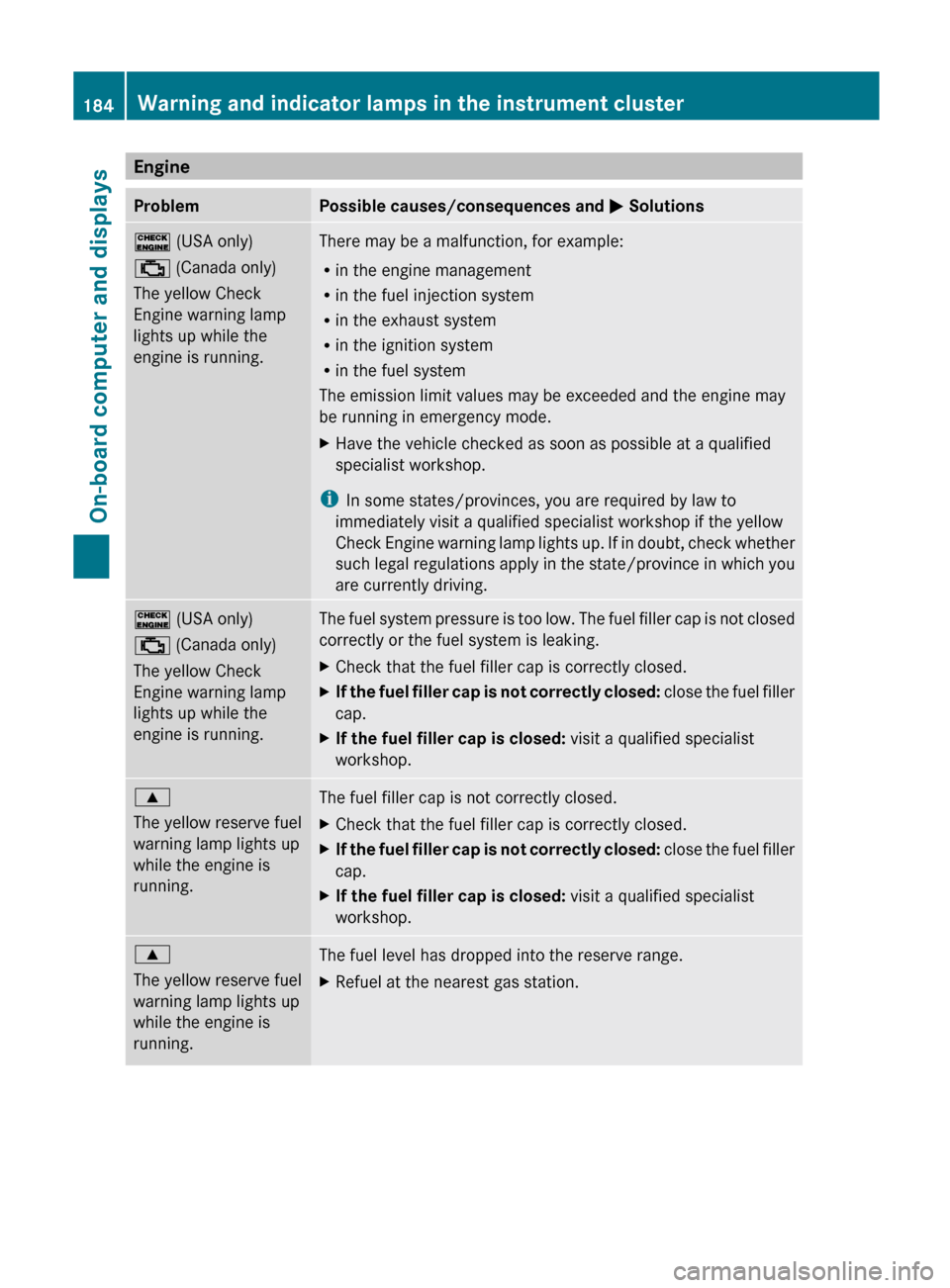
Engine
Problem Possible causes/consequences and
M Solutions
! (USA only)
; (Canada only)
The yellow Check
Engine warning lamp
lights up while the
engine is running. There may be a malfunction, for example:
R
in the engine management
R in the fuel injection system
R in the exhaust system
R in the ignition system
R in the fuel system
The emission limit values may be exceeded and the engine may
be running in emergency mode.
X Have the vehicle checked as soon as possible at a qualified
specialist workshop.
i In some states/provinces, you are required by law to
immediately visit a qualified specialist workshop if the yellow
Check Engine
warning lamp lights up. If in doubt, check whether
such legal regulations apply in the state/province in which you
are currently driving. !
(USA only)
; (Canada only)
The yellow Check
Engine warning lamp
lights up while the
engine is running. The fuel system pressure is too low. The fuel filler cap is not closed
correctly or the fuel system is leaking.
X Check that the fuel filler cap is correctly closed.
X If the fuel filler cap is not correctly closed:
close
the fuel filler
cap.
X If the fuel filler cap is closed: visit a qualified specialist
workshop. 9
The yellow reserve fuel
warning lamp lights up
while the engine is
running.
The fuel filler cap is not correctly closed.
X
Check that the fuel filler cap is correctly closed.
X If
the fuel filler cap is not correctly closed:
close
the fuel filler
cap.
X If the fuel filler cap is closed: visit a qualified specialist
workshop. 9
The yellow reserve fuel
warning lamp lights up
while the engine is
running.
The fuel level has dropped into the reserve range.
X
Refuel at the nearest gas station.184
Warning and indicator lamps in the instrument cluster
On-board computer and displays
Page 248 of 284

about the tire pressure. On vehicles equipped
with the electronic tire pressure monitoring
system, the tire pressure can be checked
using the on-board computer.
G
WARNING
Should the tire pressure drop repeatedly:
R check the tire for foreign bodies.
R check whether
the wheel is losing air or the
valve is leaking.
R make sure that only a valve cap approved
by Mercedes-Benz is installed on the tire
valve.
Tire pressures that are too low have a
negative effect on vehicle safety, which could
lead you to cause an accident.
Only correct tire pressures when the tires are
cold. The tires are cold when the vehicle has
been parked for at least three hours or driven
for less than 1 mile (1.6 km). The tire
temperature changes depending on the
outside temperature, the vehicle speed and
the tire load. If the tire temperature changes
by 18 ‡ (10 †), the tire pressure changes by
approximately 10 kPa (0.1 bar/1.5 psi). Take
this into account when checking the pressure
of warm tires and only correct the tire
pressure if it is too low for the current
operating conditions. If you check the tire
pressure when the tires are warm, the
resulting value will be higher than if the tires
were cold. This is normal. Do not reduce the
tire pressure to the value specified for cold
tires. The tire pressure would otherwise be
too low.
Observe the recommended tire pressure
specifications for cold tires on the Tire and
Loading Information placard on the B-pillar on
the driver's side.
i The specifications given on the following
Tire and Loading Information placard are
examples. Tire pressure specifications are
vehicle-specific and may deviate from the
data shown here. The tire pressures
applicable to your vehicle can be found on the Tire and Loading Information placard on
your vehicle.
You will find recommended tire pressure
specifications
: for
cold tires and for a fully
loaded vehicle's Tire and Loading Information
placard. The tire pressure information is
applicable to all tires mounted at the factory. Important notes on tire pressure
G
WARNING
If the tire pressure drops repeatedly, check
the tires for punctures from foreign objects
and/or whether
air is leaking from the valves
or from around the rim.
The tire temperature and pressure increase
when the vehicle is in motion. This is
dependent on the driving speed and the load.
If you wish to drive at high speeds of 100 mph
(160 km/h) or higher when this is allowed,
use the tire pressure table on the inside of the
fuel filler flap to set the correct tire pressures
when the tires are cold. If the tire pressure is
not set correctly, this can lead to an excessive
build up of heat and a sudden loss of
pressure.
For more information, contact a qualified
specialist workshop.
i Driving comfort can be impaired if the tire
pressure value recommended in the tire
pressure table for speeds over 100 mph
(160 km/h) is adopted. 246
Tire pressure
Wheels and tires
Page 251 of 284
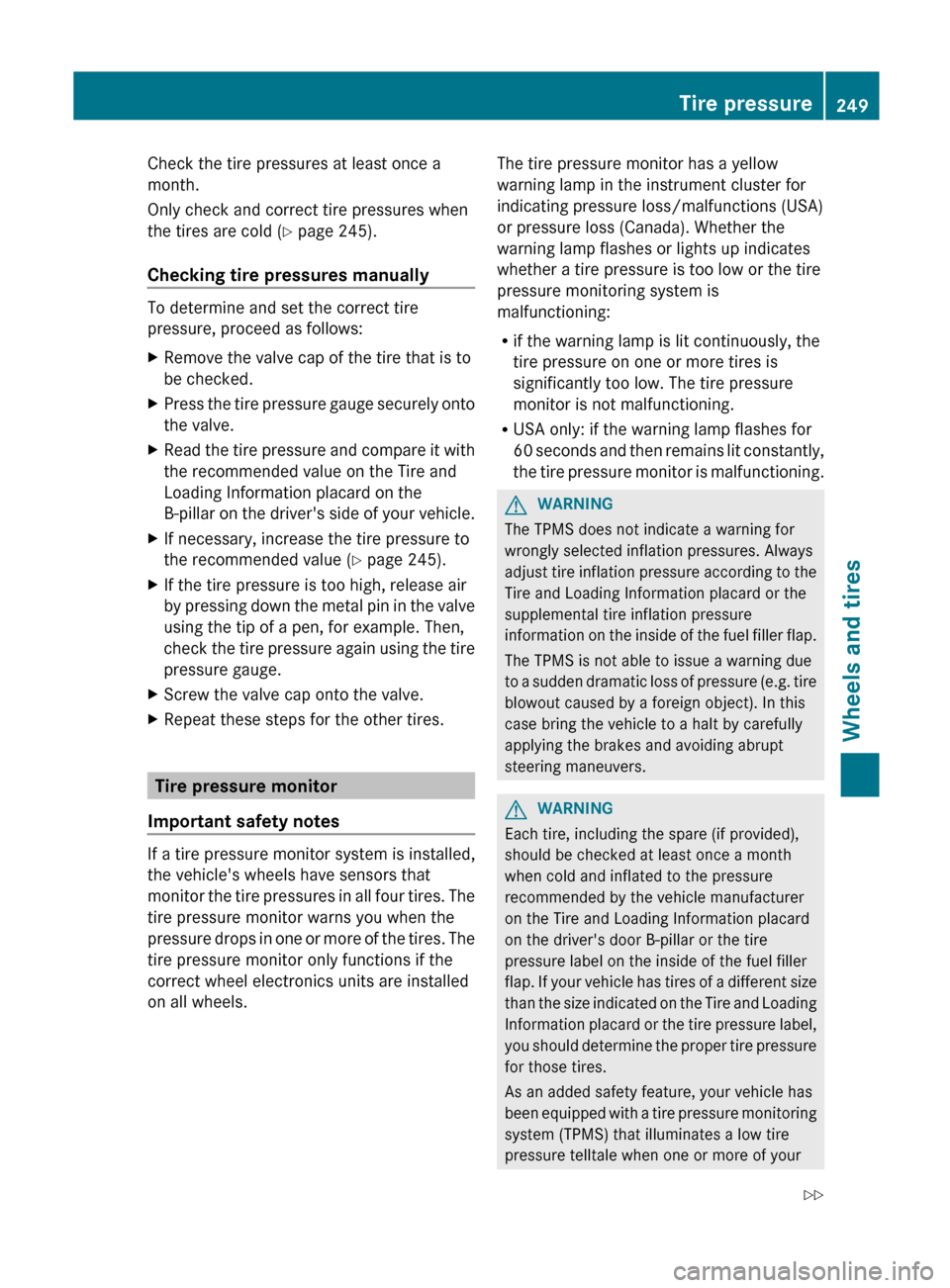
Check the tire pressures at least once a
month.
Only check and correct tire pressures when
the tires are cold (
Y page 245).
Checking tire pressures manually To determine and set the correct tire
pressure, proceed as follows:
X
Remove the valve cap of the tire that is to
be checked.
X Press the tire pressure gauge securely onto
the valve.
X Read the tire pressure and compare it with
the recommended value on the Tire and
Loading Information placard on the
B-pillar on
the driver's side of your vehicle.
X If necessary, increase the tire pressure to
the recommended value ( Y page 245).
X If the tire pressure is too high, release air
by pressing
down the metal pin in the valve
using the tip of a pen, for example. Then,
check the tire pressure again using the tire
pressure gauge.
X Screw the valve cap onto the valve.
X Repeat these steps for the other tires. Tire pressure monitor
Important safety notes If a tire pressure monitor system is installed,
the vehicle's wheels have sensors that
monitor
the
tire pressures in all four tires. The
tire pressure monitor warns you when the
pressure drops in one or more of the tires. The
tire pressure monitor only functions if the
correct wheel electronics units are installed
on all wheels. The tire pressure monitor has a yellow
warning lamp in the instrument cluster for
indicating pressure loss/malfunctions (USA)
or pressure loss (Canada). Whether the
warning lamp flashes or lights up indicates
whether a tire pressure is too low or the tire
pressure monitoring system is
malfunctioning:
R
if the warning lamp is lit continuously, the
tire pressure on one or more tires is
significantly too low. The tire pressure
monitor is not malfunctioning.
R USA only: if the warning lamp flashes for
60 seconds
and then remains lit constantly,
the tire pressure monitor is malfunctioning. G
WARNING
The TPMS does not indicate a warning for
wrongly selected inflation pressures. Always
adjust tire
inflation pressure according to the
Tire and Loading Information placard or the
supplemental tire inflation pressure
information on the inside of the fuel filler flap.
The TPMS is not able to issue a warning due
to a sudden dramatic loss of pressure (e.g. tire
blowout caused by a foreign object). In this
case bring the vehicle to a halt by carefully
applying the brakes and avoiding abrupt
steering maneuvers. G
WARNING
Each tire, including the spare (if provided),
should be checked at least once a month
when cold and inflated to the pressure
recommended by the vehicle manufacturer
on the Tire and Loading Information placard
on the driver's door B-pillar or the tire
pressure label on the inside of the fuel filler
flap. If
your vehicle has tires of a different size
than the size indicated on the Tire and Loading
Information placard or the tire pressure label,
you should determine the proper tire pressure
for those tires.
As an added safety feature, your vehicle has
been equipped with a tire pressure monitoring
system (TPMS) that illuminates a low tire
pressure telltale when one or more of your Tire pressure
249
Wheels and tires
Z